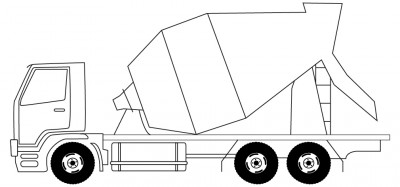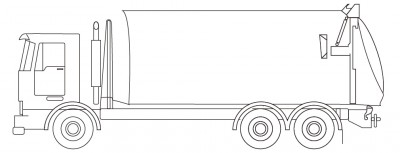This page describes specialist vehicles in the Land Transport Rule: Vehicle Dimensions and Mass 2016.
Read the definitions of dimensions and axle terms
Specialist vehicles are a type of higher mass vehicle that can carry divisible loads. They should not be confused with specialist overdimension vehicles. If they are over the general access axle mass limits they cannot be driven on the road without a permit from a road controlling authority (RCA) – usually this is the local council or the NZ Transport Agency for state highways.
The rule prescribes types of allowable specialist vehicles. They are:
- Passenger service vehicles
- Ground-spreader trucks
- Concrete mixers
- Rubbish trucks with compactor.
Passenger service vehicle
- a motor vehicle used or available for use in a passenger service for the carriage of passengers, or
- a motor vehicle with more than 12 seating positions, or
- a heavy motor vehicle with more than nine seating positions.


Ground-spreader truck
 A ground-spreader truck distributes material from its storage container, spraying the surrounding area with its contents.
A ground-spreader truck distributes material from its storage container, spraying the surrounding area with its contents.

Concrete mixer
 A concrete mixer is a vehicle designed for the purpose of transporting and mixing concrete. A typical concrete mixer uses a revolving drum to mix the components.
A concrete mixer is a vehicle designed for the purpose of transporting and mixing concrete. A typical concrete mixer uses a revolving drum to mix the components.

Rubbish truck
 A rubbish truck is a vehicle designed and constructed for the collection and transport of rubbish and to which is fitted a compactor. It doesn’t include general vehicles carrying waste.
A rubbish truck is a vehicle designed and constructed for the collection and transport of rubbish and to which is fitted a compactor. It doesn’t include general vehicles carrying waste.

Specialist vehicle conditions
Specialist vehicles that operate under permit from a road controlling authority must comply with the following conditions:
- The vehicle is not to exceed mass limits set out in a defined schedule for specialist vehicles
- For axle mass limits other than those specified in the defined schedule the vehicle must not exceed the axle and axle set limits in the general access mass tables in the rule (see Land Transport Rule: Vehicle Dimensions and Mass 2016 for these tables)
- Conditions imposed by a road controlling authority (to ensure the safety of road users, protection of infrastructure, or provide for compliance with the permit (including tracking systems))
- A specialist vehicle cannot tow a heavy trailer (GVM over 3500kg).
|
Maximum sum of axle mass for specialist vehicle operating on permit
|
|
Type of axle set
|
Mass (kg)
|
|
A single large-tyred axle in a tandem axle set with a twin-tyred axle and a 55/45 load share
|
8100
|
|
Twin-tyred axle in any axle set
|
12,000
|
|
Two axles in a tandem axle set comprising:
|
|
a) a twin-tyred axle with a single large-tyred axle and a 60/40 load share
|
16,000
|
|
b) a twin-tyred axle with a single large-tyred axle and a 55/45 load share
|
18,000
|
|
Two twin-tyred axles:
|
|
a) spaced less than 1.3 m from the first axle to the last axle
|
17,000
|
|
b) spaced 1.3 m or more from the first axle to the last axle
|
18,000
|
Like overweight vehicles, specialist vehicles need a separate permit from every RCA whose area they travel through. This includes the Transport Agency for any travel on state highways.
A vehicle operating under a permit must comply with the following critical conditions:
- The gross mass of the vehicle must not exceed the maximum gross mass specified in the permit
- The gross mass of the vehicle must not exceed the gross vehicle mass, gross combination mass, maximum towed mass or brake code mass if any of these limits apply to the vehicle
- The vehicle must comply with all bridge restrictions specified in the permit.
|
Breach of a critical condition attracts a higher fine ($2000) than a breach of other permit conditions. Further penalties for other infringements, particularly for overloading, may also apply.
|
Applying for a permit
Find out how to apply for a specialist vehicle permit


 A ground-spreader truck distributes material from its storage container, spraying the surrounding area with its contents.
A ground-spreader truck distributes material from its storage container, spraying the surrounding area with its contents.
 A concrete mixer is a vehicle designed for the purpose of transporting and mixing concrete. A typical concrete mixer uses a revolving drum to mix the components.
A concrete mixer is a vehicle designed for the purpose of transporting and mixing concrete. A typical concrete mixer uses a revolving drum to mix the components.
 A rubbish truck is a vehicle designed and constructed for the collection and transport of rubbish and to which is fitted a compactor. It doesn’t include general vehicles carrying waste.
A rubbish truck is a vehicle designed and constructed for the collection and transport of rubbish and to which is fitted a compactor. It doesn’t include general vehicles carrying waste.